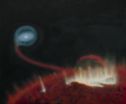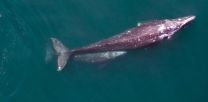Sharp-eyed Alma spots a flare on famous red giant star
2015-05-29
(Press-News.org) Super-sharp observations with the telescope Alma have revealed what seems to be a gigantic flare on the surface of Mira, one of the closest and most famous red giant stars in the sky. Activity like this in red giants - similar to what we see in the Sun - comes as a surprise to astronomers. The discovery could help explain how winds from giant stars make their contribution to our galaxy's ecosystem.
New observations with Alma have given astronomers their sharpest ever view of the famous double star Mira. The images clearly show the two stars in the system, Mira A and Mira B, but that's not all. For the first time ever at millimetre wavelengths, they reveal details on the surface of Mira A.
"Alma's vision is so sharp that we can begin to see details on the surface of the star. Part of the stellar surface is not just extremely bright, it also varies in brightness. This must be a giant flare, and we think it's related to a flare which X-ray telescopes observed some years ago", says Wouter Vlemmings, astronomer at Chalmers University of Technology, who led the team.
The team's results were recently published in the journal Astronomy & Astrophysics.
Red giants like Mira A are crucial components of our galaxy's ecosystem. As they near the end of their lives, they lose their outer layers in the form of uneven, smoky winds. These winds carry heavy elements that the stars have manufactured - out into space where they can form new stars and planets. Most of the carbon, oxygen, and nitrogen in our bodies was formed in stars and redistributed by their winds.
Mira - the name means "Wonderful" in Latin - has been known for centuries as one of the most famous variable stars in the sky. At its brightest, it can be clearly seen with the naked eye, but when it's at its faintest a telescope is needed. The star, 420 light years away in the constellation Cetus, is in fact a binary system, made up of two stars of about the same mass as the sun: one is a dense, hot white dwarf and the other a fat, cool, red giant, orbiting each other at a distance about the same as Pluto's average distance from the Sun.
"Mira is a key system for understanding how stars like our sun reach the end of their lives, and what difference it makes for an elderly star to have a close companion", says Sofia Ramstedt, astronomer at Uppsala University and co-author on the paper.
The Sun, our closest star, shows activity powered by magnetic fields, and this activity, sometimes in the form of solar storms, drives the particles that make up the solar wind which in its turn can create auroras on Earth.
"Seeing a flare on Mira A suggests that magnetic fields also have a role to play for red giants' winds", says Wouter Vlemmings.
The new images give astronomers their sharpest ever view of Mira B, which is so close to its companion that material flows from one star to the other.
"This is our clearest view yet of gas from Mira A that is falling towards Mira B" says Eamon O'Gorman, astronomer at Chalmers and member of the team.
The observations were carried out as part of Alma's first long-baseline observations. By placing the telescope's antennas at their maximum distance from each other, Alma reached its maximum resolution for the first time. Mira was one of several targets in the campaign, alongside a young solar system, a gravitationally lensed galaxy and an asteroid. Now Wouter Vlemmings and his team plan new observations of Mira and other similar stars.
"Alma has shown us details on the surface of Mira for the first time. Now we can begin to discover our closest red giants in detail that hasn't previously been possible", he says.
INFORMATION:
ELSE PRESS RELEASES FROM THIS DATE:
2015-05-28
In the first study of its kind, veterans and civilians with traumatic brain injury showed improved cognitive performance and psychological and neural health following strategy-based cognitive training. The Department of Defense-funded study, published this week in Neuropsychological Rehabilitation, was conducted by an interdisciplinary team of cognitive neuroscientists, rehabilitation specialists, and neuroimaging experts from the Center for BrainHealth at The University of Texas at Dallas.
"Veterans and others who have sustained traumatic brain injuries often experience ...
2015-05-28
Article Spotlight features summaries written in collaboration with authors of recently published articles by the Journals Program of the American Psychological Association. The articles are nominated by the editors as noteworthy to the scientific community.
Mass shootings have a significant impact on our individual and collective psyche, especially when they happen at schools. Despite the fact that children die every day from gun violence, school shootings upset us in ways that are difficult to comprehend. In our minds, schools serve as safe havens for children. When ...
2015-05-28
One recent spring day, John Durban, a NOAA Fisheries marine mammal biologist, stood on the California coast and launched an unmanned aerial vehicle into the air. The hexacopter--so called because it has six helicopter-type rotors--zipped over the ocean and hovered above a gray whale mother and her calf. The pair was migrating north from their calving grounds off Baja California, Mexico, to their summer feeding grounds in the Arctic.
NOAA Fisheries scientists have stood at this point of land each year for the past 22 years, binoculars in hand, to estimate the number of ...
2015-05-28
Life-threatening liver inflammation can be caused by excess alcohol, fatty foods, toxins, as well as viral, bacterial, and parasite infections. A study published on May 28th in PLOS Pathogens reports that a specific immune cell type in the liver can dampen the immune response, reduce inflammation, and protect against liver damage.
Alain Beschin, from the Vrije Universiteit Brussel, Belgium, and colleagues studied the immune response to trypanosome parasites in mice, where they frequently cause liver inflammation and failure. They focused on the role of monocytes, immune ...
2015-05-28
The human sensory systems contend with enormous diversity in the natural world. But it has been known for a long time the brain is adapted to exploit statistical regularities that nonetheless arise amongst this diversity. Research publishing this week in PLOS Computational Biology reports that established statistical distributions of visual features, such as visual contrast, spatial scale and depth, differ between dark and bright components of the natural world.
For scientists Emily Cooper and Anthony Norcia, gaining a more detailed description of statistical regularities ...
2015-05-28
Retrograde amnesia is the inability to recall established memories. In humans, amnesia is associated with traumatic brain injury, Alzheimer's disease, and other neurological conditions. Whether memories lost to amnesia are completely erased or merely unable to be recalled remains an open question. Now, in a finding that casts new light on the nature of memory, published in Science, researchers from the RIKEN-MIT Center for Neural Circuit Genetics demonstrated in mice that traces of old memories do remain in the amnestic brain, and that the cellular pathways underlying them ...
2015-05-28
Elevated plasma triglyceride level is considered a risk factor for type-2 diabetes, but new findings suggest that a genetically-elevated triglyceride level is associated with protection against type-2 diabetes. Yann Klimentidis, an Assistant Professor at the Mel and Enid Zuckerman College of Public Health at the University of Arizona, and colleagues found that triglyceride-increasing alleles are associated with decreased type-2 diabetes incidence. Their findings were published recently in PLOS Genetics.
Building on previous studies that hinted to the same association, ...
2015-05-28
Dany Gaillard and colleagues at the University of Colorado Anschutz Medical Campus have discovered a key molecular pathway that aids the renewal of taste buds, a finding that may help cancer patients suffering from an altered sense of taste during treatment. Their findings were published recently in the journal PLOS Genetics.
"Many cancer drugs which circulate throughout the entire body, will target a tumor but in the process affect healthy cells," said the study's senior author Linda Barlow, a professor of cell and developmental biology at University of Colorado Anschutz ...
2015-05-28
AURORA, Colo. (May 28, 2015) - Researchers at the University of Colorado Anschutz Medical Campus have discovered a key molecular pathway that aids in the renewal of taste buds, a finding that may help cancer patients suffering from an altered sense of taste during treatment.
"Many cancer drugs, which circulate throughout the entire body, will target a tumor but in the process affect healthy cells," said the study's senior author Linda Barlow, PhD, professor of cell and developmental biology at CU Anschutz. "That in turn will alter a person's sense of taste leading to ...
2015-05-28
CAMBRIDGE, MA -- Memories that have been "lost" as a result of amnesia can be recalled by activating brain cells with light.
In a paper published today in the journal Science, researchers at MIT reveal that they were able to reactivate memories that could not otherwise be retrieved, using a technology known as optogenetics.
The finding answers a fiercely debated question in neuroscience as to the nature of amnesia, according to Susumu Tonegawa, the Picower Professor in MIT's Department of Biology and director of the RIKEN-MIT Center at the Picower Institute for Learning ...
LAST 30 PRESS RELEASES:
[Press-News.org] Sharp-eyed Alma spots a flare on famous red giant star




